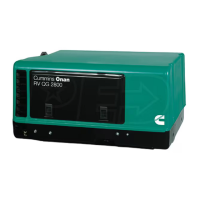Section
8.
Generator
b
INTRODUCTION
The
KV
generator set uses a 2-pole, revolving field,
generator design and an electronic voltage regulator.
All AC
load connections are made through generator
lead wires that connect directly to a customer supplied
junction box.
A
circuit breaker provides overcurrent
protection for the generator and also functions as an
on/off switch in the load circuit.
GENERATOR DESCRIPTION
The generator consists of the following major
components:
0
Stator and housing
0
Rotor
0
Electronic Voltage Regulator
0
Brushes
Wiring Harness
The stator consists of a number
of
steel laminations
stacked together, with three separate windings wound
onto it in a torroidal fashion. Winding T1 -T2 is the main
power winding that provides the voltage and current to
operate the connected loads. Winding B1-62 is for bat-
tery charging and internal low voltage loads. Winding
Q1 -Q2 is an excitation winding that provides power to
the voltage regulator. The stator mounts inside the
generator.
Rotor
The rotor consists of a number of laminations stacked
together,
a
field winding wrapped around the lamina-
tions, a shaft through the laminations, molded slip rings
on the shaft and a bearing pressed on the shaft. The
entire assembly is connected directly to the tapered
engine crankshaft by means of a throughbolt. The rotor
is supported
on
the other end by the endbell, which is
placed over the bearing and secured to the housing.
The rotor field winding provides the rotating magnetic
field which in turn generates the voltage and current in
the stator windings
to
power the connected loads. The
from the brushes through the slip rings and the field
winding.
t
magnetic field is established by a
DC
current flowing
Generator
Cooling
Cooling airflow for the generator is provided by a cen-
trifugal fan mounted on the shaft behind the bearing.
A
portion
of
the airflow from the fan is directed into the
generator. Part of this air flows down the rotor cooling
the rotor winding, and the rest flows over the stator
windings cooling them.
Electronic Voltage Regulator
The electronic voltage regulator controls the output
of
the generator
so
that the voltage remains constant
under any load condition.The electronic voltage regula-
tor takes power from the excitation winding, rectifies it,
and feeds it into the field winding through the brushes
and slip rings. The regulator reads the output of the
power winding and its circuitry decides how much cur-
rent should be fed into the field winding to maintain the
proper output at various load levels.
Brushes and Brush Block
The brush block isaone piece molded partthat mounts
inside the endbell. There are two carbon brushes in the
brush block which ride
on
the slip rings and provide the
means by which the controlled
DC
current from the
regulator is conducted into and out of the rotor. Each
brush is kept in contact with its slip ring by a spring
mounted inside the brush block behind the brush. The
spring exerts just the right amount of pressure to pro-
vide good contact and long brush life.
Wiring Harness
A
separate wiring harness is provided for connecting
the generator set to the
RV
electrical system. All lead
wires are stranded copper wire to withstand vibration.
The lead wires must be protected with flexible conduit
which must be provided by the
RV
manufacturer or
generator set installer.
A
112
inch conduit elbow is
provided to facilitate installation. The load wire conduc-
tor is black, the neutral conductor is white, and the
ground conductor is green.
8-1

